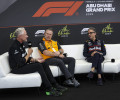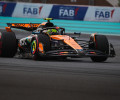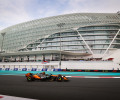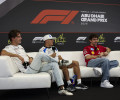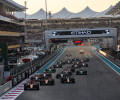F1 - 2025 Singapore Grand Prix - Friday Press Conference Transcript

TEAM REPRESENTATIVES
James VOWLES (Williams), Steve NIELSEN (Alpine), Andy COWELL (Aston Martin)
Q: Andy, can we start with you? A strong start to the weekend with Fernando in P1 in first practice. Without wanting to get carried away, can you just tell us why the car appears to be working better here than it has done at the last couple of races?
Andy COWELL: I think this circuit characteristic suits our car a little bit better. We struggle on the higher speed tracks—Baku, as an example— a long, fast Sector 3, high downforce, car pushed down. You’ve got to lift the car so you don’t wear the skid out. But then around Sector 1 and 2, you’ve got a car that’s sat higher up. Here, I guess it’s a little bit like Baku but without Sector 3.
Q: What does this mean for the rest of the weekend?
AC: I guess what it means is we’ve had a mixed FP1. You want both your cars tightly packed somewhere up near the front, so there’s work we need to do to investigate the set-up on Lance’s car. We’re doing a very detailed comparison, back-to-back. Our tyre choice was a little bit different to everybody else. We were the only ones running mediums at the start. And as you know, Tom, you should never place a bet after FP1 results. There are no points on a Friday.
Q: Given everything you’ve just said, can we throw it forward? Which race tracks do you think will suit the car between now and the end of the season?
AC: I’ll let you know after each event.
Q: Is the car that unpredictable?
AC: No. There’s just many competing systems, as these guys know. Many, many competing systems. And we’ve all come here, the track’s been resurfaced, both drivers commenting that it’s smoother. There’s great traction. And so you react to that. And at a night race, FP1’s not the most representative session, so you just have to adapt as you go along. It’s the same at all the coming races. We’ve got an inkling as to which circuits, but I’m not going to pass that on to you.
Q: Let’s take it one race at a time then. What are your goals for the rest of the season? You’re P7 in the Constructors’. What do you want to see from the team?
AC: What we want is every single race, we go along and we set the car up as best we can with the hardware that we’ve got. We follow the track. We have a beautiful qualifying session, great first lap, an awesome strategy, and we pick up the most points from every race. We would love to finish ahead of James and Williams, but congratulations to James on the podium at the last race—well done. It makes our dream of finishing fifth tougher, but that’s still what we’re fighting for.
Q: Can I bring you onto the subject of Fernando Alonso now? He said something very interesting recently when asked about his longer-term future in Formula 1. He said he had more chance of retiring if things go well in 2026 than if they go badly. Are you aligned with him on that?
AC: I think that’s linked to—we all want to finish on a high. He’d like to finish his driving career winning races, doing well in races. So I think that’s what that’s linked to. He’s a huge part of the team. Really useful to have him on board, and Lance this year and into next year, providing guidance on what’s important for the ’26 car, work in the DIL sim and car configuration work and so on. But yeah, I think it comes back to that. Last race for Fernando, top step of the podium—that’s what we all dream of.
Q: Final one from me. There are a lot of rumours swirling around in the paddock about the future of Christian Horner. Ayao Komatsu said yesterday that he had approached Haas. Has he approached Aston Martin?
AC: I guess this popped up yesterday in our media session. I had a chat with Lawrence this morning to find out what he knows. It looks as though Christian’s ringing up pretty much every team owner at the moment, so you can pass the question along. I can clearly say there are no plans for involvement of Christian either in an operational or investment role in the future.
Q: Steve, let’s come to you now. A very warm welcome to the FIA press conference. Can we just start where we finished? Has Christian Horner approached Alpine?
Steve NIELSEN: As far as I know, no. But Flavio and Christian are old friends, that’s no secret. What they’ve talked about, I don’t know. But everything I see and everything I know, there’s no truth in Christian coming to Alpine—but that doesn’t mean it won’t happen. This is Formula 1 after all.
Q: You’ve been back at Alpine, back at Enstone, for just over a month. Describe what you found. How’s it going?
SN: It’s like going back to an old school. Have you ever done that? You go back to an old school and bits of it are really familiar but a bit smaller than you remember. Bits of it are new. It’s been great to go back. They’ve made me feel very welcome. Some old familiar faces, lots of new faces, which is also good. But whilst I’ve been in the sport for this time I haven’t been at a team for eight years. So there’s a big part of me getting up to speed and picking up on what’s changed inside a racing team in the last eight years—and there’s an awful lot. Things like budget cap didn’t exist the last time I was part of a team. Now it does. And it’s really bizarre for me because I was on the other side of that at F1 in the early discussions, and then that was taken forward, implemented, and enforced by the FIA. So to now be on the receiving end of it is a whole new experience for me. A lot to learn on my side as well.
Q: Is the Enstone spirit still alive and kicking?
SN: Absolutely. It is. Of course it it. It’s a great place. There’s some fine talent there. What we put on the track at the moment doesn’t reflect the skills we have there and the facilities we have there, and it’s our job to turn that around.
Q: Can you clarify what the job is as well? You’re MD. What does that mean on a day-to-day basis?
SN: Flavio is the leader. I run Enstone and everything that comes with that. That’s how we go forward, and we’re clear internally about what those responsibilities are and how that’s carved up. That’s how we’re doing it.
Q: Final one from me—drivers. Franco has gone better in the last few races. I think he’s out-qualified Pierre in three of the last four. Give us your assessment of his progress and when we can expect a decision on your second driver for next year.
SN: I think it’s difficult for any of the new drivers coming in. We’ve seen ebb and flow in lots of them that have come from F2—five came from F2 last year, which is good. Franco had a difficult start. I think we’ve seen that equalise and calm down a little bit. He’s now had the measure of Pierre in the last two or three races. So he’s on a par with him, which is good. We don’t know where that slope will end—whether it’s going to continue. We hope it does. And then we’ll make our decision on Franco and whoever else is in the frame when we have to. But we’re a few races away from that yet.
Q: James, thank you for waiting. Let’s continue Andy’s theme—has Christian Horner approached Williams?
James VOWLES: No.
Q: Can we just clarify what happened to Alex’s car in FP1?
JV: Everything looked okay up until Turn 10 of that lap where we boxed him, and then all of a sudden the rear brake temperatures ramped up to a level you really don’t want them—which is plus 1,000. So it looks like part of the rear circuit, probably around—hard to know exactly—but something in the rear circuit anyway, hardware-wise, basically clamped on a little bit of braking force. And even though it came in slowly, by that point it was too late.
Q: Can we talk about the podium last time out now? Alex said in here yesterday that the podium proved a point and it was a taster of what’s to come. Can you give us your take on what the podium means to you and the team?
JV: I’m incredibly proud of Williams because it’s a team that has such a fighting passion and spirit inside it, but it was just surviving for so many years. Even when I turned up, it was still in that survival mode. Everyone has diligently, and with almost no obstacle put in the way, changed in the way we need to become competitive again. The reward wasn’t just seeing the mechanics and Carlos and Alex who was right by my side for the podium. The reward was taking the trophy, putting it back in reception in the factory, and I went down every hour or so to see 50 or so people there. Emotional—tears, crying, laughter, happiness—it meant the world to them. And it meant the world to me to see that. It’s a boost that drives a team really far forward. It’s belief, it’s not my words anymore that are required. They can see it, breathe it, live it at the same time.
Q: Carlos has had his frustrations this year. Did the podium come at a good time for him?
JV: I think any podium comes at a good time, but definitely it was a point in the season where—I think to a certain extent it’s hard to put down exactly in words what has happened this year because it’s no one thing. It’s never been a repeat of exactly the same. He has performance. He can out-qualify Alex, but it never came together in the race. I think for him it was a really good moment and an opportunity to show why we put our trust and faith in him—and vice versa.
Q: Do you expect him to kick on from here? Will we see a stronger Carlos somehow?
JV: I’m confident we will. But this is a mental game after all. They’re all pretty muscly, don’t get me wrong, but it is a mental game. You really do take a positive momentum spin from it, and I’m confident you’ll see Carlos step up.
QUESTIONS FROM THE FLOOR
Q: (Jon Noble – The Race) To all three of you. It's now 115 days until the Barcelona test starts. Can you just give an indication of the scale of the challenge that still lies ahead, especially now you've got a Christmas shutdown, so you can't force people to work over the break? Is it a situation where you'd be raring to be out the pit lane at 09:00 on January 26, or is it just a case of trying to get there for the final three or five days?
AC: Yeah, it’s a big challenge for all the teams. Lots of new technology—power unit, advanced sustainable fuels, aerodynamics, materials development, chassis design, transmissions—it’s the whole car. And it’s exciting. It’s an exciting challenge. None of us can move that first test date or the first race date. We’re all pushing as hard as we can to innovate and create performance. But we all know that you don’t get any points unless you finish, and we’ve got that eternal balance to make. I think it’s going to be exciting racing, exciting testing compared with the last few years where you do a few days. It’ll be interesting to see how it all unfolds, but we’re certainly looking forward to it.
Q: Andy, on this topic, how’s the integration with Honda going?
AC: Yeah, Honda’s going great. They’re an engineering-led organisation, just like Aston Martin. They’re innovative, their sense of passion and commitment and courage is huge. I’m flying to Sakura on Monday, spending a couple of days with them after the race on Sunday. It’s an exciting time for the team to take that transition from a customer team, where you have very little say in what goes on at the rear of the car, to having all the debates about what the front of the power unit should look like, how do we do the cooling, how do we integrate with the transmission, how do we pull it all together. I guess that’s where Adrian being on board since March is really helpful. He’s got experience working with Honda, so there’s a natural understanding there already as to what can be pushed and what can’t. So yeah, exciting times.
SN: Similar answer to Andy, honestly. We’re also changing PU supplier—it’s no secret. And the winter is going to be, I was going to say, very short—almost non-existent. I think we’re starting our car next year before the end of this season, and we’ll be running it something like four weeks after Abu Dhabi. So with Christmas and the shutdown... it’s incredibly compressed. Enstone’s already buzzing with activity, making chassis and so on. It may look from the outside like you finish one season and start another one, but the overlap is enormous. We’re already fully into next year’s car—producing it.
JV: Very well summarised. I’d say the same thing. It’s a clean sheet of paper. I think this is probably the biggest rule change we’ve ever gone through because of changing power unit and chassis at the same time. But I relish the opportunity simply because for us, it’s an opportunity to undo ten or fifteen years of the way of doing things in the car and start again from scratch. It’s a heck of a challenge, but that’s frankly why we’re all here at the same time.
Q: (Ian Parkes – RacingNews365) James, you said there’s been no approach from Christian. If he did, would you welcome a conversation? Could you see any opportunity for him at Williams?
JV: I think you should always welcome a conversation. There’s no point closing the door. But I think we are very happy with the structure we have, and it’s working. So I don’t see any reason to make any changes to that.
Q: (Deepanraj Ganesan – The Straits Times) Question about next year’s Sprint race. I think the choice of Singapore has clearly raised a few eyebrows, because of how tight the track is and people saying there’s no opportunities for overtaking. What’s been the teams’ reaction to Singapore being chosen as a Sprint race, and what kind of opportunities do you see next year? Who’d like to start? Steve?
SN: I think Sprint races have been a good thing. Maybe I’m a lone voice on the couch here, but I think Sprint races have been a good thing. And I say that as somebody who, to begin with, was not that enthusiastic. But I would like to see more of them. And I think when we do races now where we have three free practice sessions, it seems very long. And I think it would be nice for the guys and girls in the grandstands to have more stuff to look at. So I would be an advocate of having more Sprint races, and I’m happy there’s one in Singapore.
Q: You say more, Steve. Like MotoGP, would you welcome it every race?
SN: I think there’s a happy number—I’m not sure what it is. Greater than six, less than 24. It wouldn’t work everywhere, but we can definitely do more than we do now.
Q: James, your thoughts, please?
JV: Mine’s slightly different. I’m not worried about Singapore. What we see on Sprint race weekends is the numbers go up, the audiences go up—so it is generally a hit. I’m more someone that would like to debate whether we go to a two-day weekend—Saturday and Sunday—same thing, just reduce the amount of free practice and make it a spectacle. By doing that and giving back 24 days to the teams, actually you could do a few more race weekends if you wanted to as well. So slightly different out-there suggestion. I think six Sprints is about the right number. I frankly don’t care where they are—it’s fine being here. You are right—overtaking is difficult, but in some regards, these races have been set up for Safety Cars and slightly out-there propositions. What we haven’t had yet is a Sprint race where someone takes a safety car stop and fights through the field. So Singapore could be that next year.
Q: Andy?
AC: I think it’ll be interesting to see what the overtaking’s like next year with the new regulations. We may well see more overtaking. So therefore, Singapore being chosen isn’t a problem. The fans love Sprint race weekends, and we work for the fans. So I support it. I don’t know exactly the same as Steve—maybe you could do more, but twenty-four might be a push too far.
Q: (Reilly Sullivan – Maxim, Australia) Steve, is there any update on Jack Doohan’s future in 2026 in a reserve role? And James, would you be interested in him as a reserve?
SN: Jack is still part of our programme. He drove for us the first few races of the season. We made a change. Franco is now in the car. We constantly assess our options. As I said at the beginning, we’ll make decisions when we have to, but I can’t give you an update on if or when he will drive again.
JV: From our side, as far as we’re aware, Jack is contracted to Alpine. We have our own young driver programme—we’ve got Luke, who’s second in the [F2] championship. And for me, as we did with Franco as well, it’s about developing our own internal structure and drivers.
Q: (Ian Parkes – RacingNews365) James, just to pick you up on your out-there suggestion—as you just described it—is that something you’ve proposed at an F1 Commission meeting? Spoken to Stefano about it? The obvious offset is, if you do go to more Grands Prix weekends, it means the promoters, like Singapore for example, would have less track days—less investment coming in from fans at the turnstiles. How would that offset?
JV: You’re spot on—it has to be working hand in hand with promoters, and that might need a different fee structure. But if you had two more Grands Prix, I think that would significantly outweigh the impact of a Friday missing, just on the economics of it. The F1 Commission is... how do I put this... often difficult to have a structured conversation like this. But it is definitely one that I’ve spoken to Stefano about. I don’t mind if we move there or not, but we should contemplate it. We tried this a few years ago—we ended up with a two-day weekend—and it was surprisingly good, in my opinion.
Q: Do you think we could mix and match? Have some three-day weekends and some two?
JV: Definitely. For clarity, I’m not saying go one way or the other particularly, but I do think—like we’ve all said here—three free practice sessions is actually quite a bit now. We’re a sport and entertainment, and we do this for the fans. So variability is not a bad thing, and variability will happen as a result of less track time.
Q: (Jon Noble – The Race) Just again, back on the 2026 topic. Your teams have now been working on these cars since January, basically. What have you kind of learned about them? What is the racing going to be like? And what are the big uncertainties that you probably won’t have answers to until either testing or the first races next year? James?
JV: I think Andy said it—the overtaking will be different, but it will happen. It’ll just be in a different way to what you’re used to now. I said this in a different forum, but the drivers had a go once and thought, “this isn’t great.” Then the second time, went, “that’s interesting.” Then by the third or fourth time—as they’re race drivers—they were actually really into it. And there’s a very different way of optimising it as a solution, and they can see how the advantage can come in. So from that perspective, I think it will be interesting. I do think it will increase overtaking—just not in the areas you think it will. That’s probably the right way of putting it. The challenge is, frankly, that everything changes. So there’s a lot of learning that we’re going through almost week by week, especially on the energy side—how do we use it in the most efficient way possible?
Q: James, what areas will be different? And will the drivers be busier in the cockpits next year?
JV: I think the way the rules are at the moment, they will be busier in the cockpit. I don’t think that’s a bad thing. I think you’ll get those that come out on top as a result of it—those that are completely in control of the car and its behaviours and then thinking outside the box. The areas that are different... probably the right way of putting it to you is, you can almost fill the entire battery in one braking zone, but you can deplete it in one straight. That’s for sure. And so that creates a very different dynamic to what we have this year.
Q: Steve, can we bring you in on this, please?
SN: Honestly, I don’t think I’d add anything to what James has already said. I would agree—no faster down the straight, slower around the corners. Lap times will be less than they are at the moment, but I don’t think that will detract from the racing. I think Andy’s point is the most interesting—what will overtaking be like remains to be seen.
Q: Andy, any more from you on this?
AC: I guess what we don’t know is exactly where everybody is going to be on efficiency levels of the power and efficiency aspects of the aerodynamic package—both in cornering mode and straight-line mode—and that relative performance will play into the spectacle of the race as well. I think it’s going to be fascinating to see how it all unfolds. Every single team is learning something new every single week, as systems mature and simulations unfold. And as James says, as drivers get involved and explore. It’s going to be fascinating for the outside world watching it all as well. I think it’s going to be a great season.
Q: (Adam Cooper – Adam Cooper F1) Andy mentioned the spectacle and the power units. Do all three of you have concerns about the field spread? Because fans have got used to very close racing the last few years. If there’s a big disparity between the power units, how much might the teams be spread out and how long might it take to address that and close the field up?
AC: I don’t have any concerns about that. That’s just natural competition when there’s a reset on everything. The industry’s shown that if there is a gap, it closes up quickly—that’s part of the sport. I’m sure we’ll see a team come up with the best aero package, a power unit manufacturer come up with the best PU. The tyres are new as well, so understanding the tyres, the energy deployment that we’ve already talked about—a team will be the best at that. And it’s unlikely that a team will be the best at all the individual parts. So it will balance out, I think.
Q: Andy, just quickly—do you think Honda go into next season at a slight disadvantage having only one team? And how critical are those tests going to be—that you have clean sessions?
AC: I think there’s always a balance. If you’ve got more teams, you get more track mileage. But if you have fewer teams, you can leave the point that you go from development into production later—so you have more time in the development phase. I think it’s going to be more down to the attention to detail rather than that. The test at Barcelona—three days of running. Are we all going to be doing 800 kilometres each day like we did in Bahrain 10 months ago? No. We’re going to be pulling everything together and making sure that everything works. The car will go around the track and come back under its own power. It’s going to be that sort of thrill of the development phase, which is exactly what it was like in Jerez in 2014 when we first all rolled out. And cars did roll out at 09:00 in 2014 and did many laps. That’s the remarkable thing about this industry. There are some great engineers, a great supply chain, operationally awesome teams, and everybody’s pushing hard to do the best in their field.
Q: Steve?
SN: I’d agree with all that. My personal view is that when you get big changes in regulations, that will spread the field out. People will iterate towards the same solutions very quickly—it will close up. If I could change anything about it, it would be that we should really think carefully before we change again, because you often get the best racing at the end of a set of regulations. I just think we should hold on to that the next time we get there and perhaps not be so quick to change it. That doesn’t mean I’m not a fan of the new cars, but when we eventually iterate to good racing—as we will quickly—then let’s stay there for a bit.
Q: James?
JV: I think mostly all said. But what I would say is I don’t think this is going to be 2014 levels at all. I think it’ll be a lot closer than that—just to alleviate people’s fears. But more than that, we’re already having open dialogue now at this stage of “what if?” What if a power unit manufacturer is ahead or behind—how do we make sure? Because we do recognise… We are a sport, but we’re also here for the racing. And to the point of the question—making sure that we are racing each other on a very similar wavelength. So, watch this space. But as Andy said, people will catch up quickly.
Q: (Jon Noble – The Race) Going back to 2026 and the overtaking aspects. Obviously the current regulations are very dependent on DRS zones and the length and downforce levels. But next year, with manual override—is it going to make overtaking possible in places where it’s not possible now? Could it, for example, make overtaking possible through the Monaco tunnel and out the tunnel, because of the speed differentials between cars?
JV: Are you writing an article about overtaking?
Q: (Jon Noble – The Race) Eventually—if I get an answer!
JV: You’ll probably protect the regions with energy deployment where overtaking is most likely to happen. So taking your example—the Monaco tunnel—I think it’s unlikely you’ll get a differential through there. But I think you’ll move away from, say, Spa—your typical overtaking point is, for example, up into Turn 5. That’s one of the main areas. Actually, it opens up the door for a few other areas around that lap. That’s probably the right way of putting it to you.
SN: I’ve got nothing to add from what James has said.
AC: I think there’ll be some surprises.
ENDS

 Facebook
Facebook Twitter
Twitter